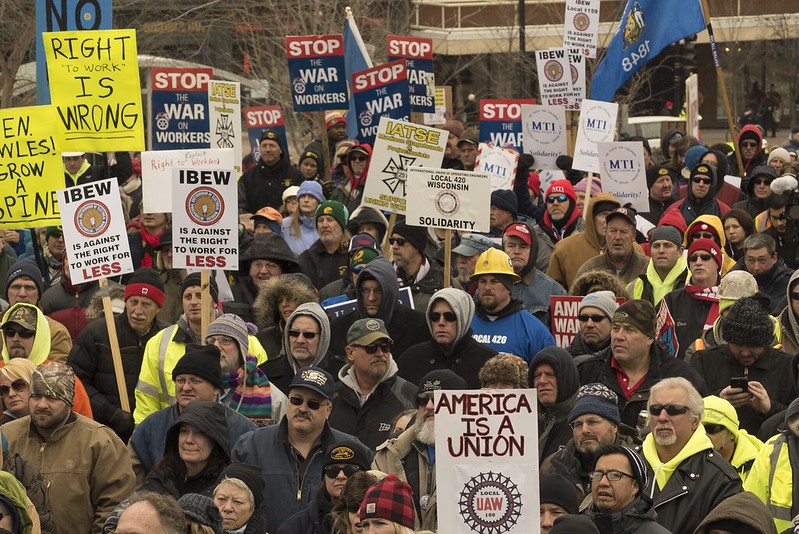
Right to Work laws were a centerpiece of the 1947 Taft-Hartley Act that curbed many of the victories won by labor unions in the previous two decades. These laws allow for a state to prohibit union membership or the contribution of union dues as a precondition for employment at a firm.
Proponents of Right to Work argue that it removes an unjust restriction placed on worker freedom, while opponents argue that it further fragments and undermines an already weak system of labor protection for ordinary workers.
Today, 27 states with about half the US population have enacted Right to Work laws. Scholars have described Right to Work laws as some of the most consequential antilabor provisions passed in the 20th century, and many local, regional, and national social movements have been motivated to act by the prospect of a state passing or repealing these laws, as one can see with the contentious political activity surrounding Wisconsin’s passage of Right to Work in 2015 and Missouri’s repeal in 2018.
Previous research has shown that Right to Work laws lower union membership rates, reduce the chances of unions successfully organizing, and shift successful organizing campaigns to smaller firms. And one of the most well-established empirical regularities in stratification research, both in the United States and cross-nationally, is that strong labor unions reduce economic inequality.
I assumed, given these two sets of findings, that the passage of Right to Work would increase inequality. Yet most previous research finds that Right to Work laws have, at best, minimal influence on economic inequality. These findings didn’t make sense to me. How could laws that so straightforwardly affect labor union power and that have motivated political action for three-quarters of a century have such minimal influence on key economic indicators like inequality?
In my recent article published in the American Journal of Sociology, I argue that these seemingly contradictory findings can be reconciled if we think of Right to Work laws as having different consequences in different social contexts, based on the preexisting power of labor unions.
For example, consider a hypothetical state that has criminalized all attempts to organize a union, so that the state has a 0% union membership rate. If this state then passed a Right to Work law, what would we expect to be the influence of Right to Work on economic inequality? Given the preexisting absence of union influence on economic outcomes, it is unlikely that a Right to Work law would do much other than reaffirm that point that unions are not significant players in the economy.
But when passed in places where unions have meaningful power to lose, Right to Work may provide either a real or symbolic opening for employers to pursue their interests more aggressively, making it more difficult for unions to demand a higher share of economic rewards.
To test this expectation, I collected data from a variety of sources, including the IRS, the US Census, the American Community Survey, the Current Population Survey, and the National Labor Relations Board. I constructed inequality information in US states and local labor markets between years 1939 and 2016 in order to assess the long-run consequences of the passage of Right to Work laws.
Like previous studies, I found, at best, mixed results in the association between Right to Work laws and economic inequality when assessing a single change across contexts before and after the passage of these laws.
But when I allowed the effect of Right to Work laws to vary across places based on their union membership, a more robust and consistent finding emerged. In states that had not passed Right to Work laws, I found that those places with higher union membership indeed had lower inequality. Yet among states with Right to Work laws passed, there was no connection between union membership and inequality.
Substantively, this means that Right to Work laws had relatively large effects that increased inequality when passed in places with high union membership rates, but relatively little effect when passed in places with few union members. Put bluntly, Right to Work laws are very effective at raising economic inequality, when they are passed in times and places where labor has something to lose.
Why is this the case? In additional analyses, I found that union membership declined at higher rates following Right to Work passage in more highly unionized contexts, and that antiunion firm activities occurred more frequently in more highly unionized Right to Work contexts compared to highly unionized states without Right to Work laws. These results suggest that Right to Work may provide the opportunity for employers to more aggressively pursue their interests against those of workers, resulting in ordinary workers having less successful bargaining leverage to raise wages, thus resulting in higher inequality.
These results speak to the importance of politics and policy for the current state of high inequality that we find ourselves in. The declining economic position of middle and lower-paid American workers well-documented in previous research is not solely the result of economic and demographic changes beyond our control. Rather, it is at least partially the result of actions taken over three-quarters of a century to reduce the power and influence of one of the few labor market institutions in the United States that focuses squarely on the wellbeing of ordinary workers.
Furthermore, the varying effects of Right to Work Laws underscore the point that policies do not have a one size fits all consequence across different places and historical eras. Seemingly identical Right to Work laws can have vastly different outcomes depending on the state of labor unions in the local context.
Read More
Tom VanHeuvelen, “The Right to Work, Power Resources, and Economic Inequality” in American Journal of Sociology 2020.
Image: America is a Union via Flickr (CC BY 2.0)

No Comments